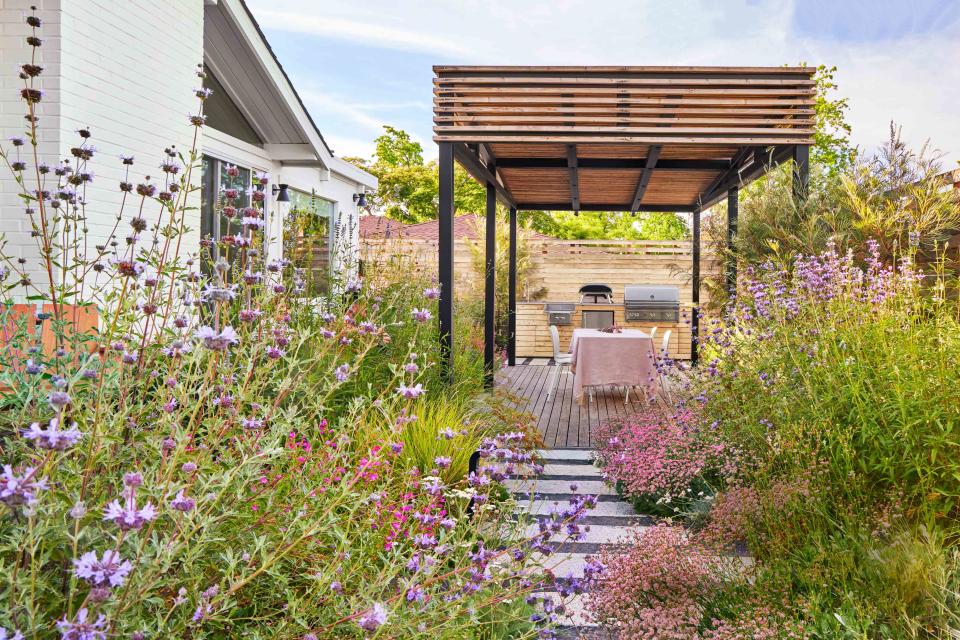This Gorgeous Yard Proves a Flower-Filled Meadow Is Possible, Even in a Small Space
A California family's meadow garden supports pollinators where their front lawn used to be.

Caitlin Atkinson
If Ann Le and Steven Huynh’s garden inspires daydreaming, that’s by design. A few years ago, the couple hired Terremoto, a California-based landscape design firm known for its “wildness and creativity,” as Ann puts it, to replace their patchy lawn with a garden that would fuel their young daughters’ imaginations. Lead designer Sarah Samynathan’s vision—“to contrast the clean architecture of the midcentury modern house with a soft, playful meadow”—delivered just the kind of landscape the couple had in mind.
The meadow design has a secondary beneficiary: pollinators. For both the front and back yards, Samynathan selected a mix of California natives and non-natives that would increase biodiversity in the space. She plotted the plants on a calendar according to bloom times, then positioned them in the landscape to make sure there was always something in flower. While Ann and Steven’s initial motivation for the landscape design was their children, Ann says the couple find themselves equally enraptured by the blooms, bees, and butterflies that now fill their yard.
The Meadow Gardens
The designer incorporated an amalgam of textures, colors, and fragrances in the plantings. The lavender flowers of coyote mint, a California native, spill onto the pathway. Pink ‘Red Rocks’ beardtongue and fragrant blue sage (Salvia clevelandii) add softness to the garden, while islands of white pompons of ‘Alba’ sea thrift dot the pathways; the couple love how the plants seed themselves, with new growth popping up in unexpected places.
A series of pathways lined with reclaimed granite pavers and permeable black basalt gravel connects the various spaces and encourages meandering. The girls often walk through the flowers, clipping stems for bouquets and art projects.
After getting rid of their front lawn, which required a lot of water and hosted little biodiversity, Ann and Steven appreciate that their yard is now a haven for insects and birds, who are drawn to plants like the pale blue bog sage (Salvia uliginosa) and native yarrow.
"Since a lot of the plants we have are California natives, we now notice them out in the wild. Our garden has given us a whole new appreciation for them.”"
—Ann Le
The Living Spaces
The garden was designed to handle summer heat. A pergola, which mimics the sharp lines of the house, keeps the dining area cool. The couple (who recently opened a natural wine bar called Goodtime Bar) put the outdoor kitchen to heavy use. A high-powered burner for making stir-fries, a grill, smoker, sink, and small refrigerator provide everything they need to cook elaborate outdoor meals.
A concrete firepit surrounded by plantings gives the family a cozy pocket to hang out and roast s’mores. The fence is made from the same cedar wood as the pergola and will develop a silvery patina over time.
In an interior courtyard, Terremoto created an angular deck. To contrast the wild meadowlike landscape, they kept planting to a minimum: A single ‘Sango-kaku’ Japanese maple tree, whose bark will redden in winter, and a cluster of ferns, including maidenhair, deer, Mexican polypody, offer a peaceful moment of green.
Between the lush plantings and the outdoor spaces, the designers ensured that the space is inviting to both pollinators and people year round. Although the couple didn't use to think of themselves as "garden people," says Ann, "now we’re outside all the time and have so many butterflies, bees, and hummingbirds. Our yard has a life of its own.”
Terremoto
Through its striking naturalistic gardens, 10-year-old landscape design firm Terremoto is leading the field of sustainable gardening. From its offices in San Francisco and Los Angeles, the studio takes on a range of projects, from tiny backyards to urban public spaces. The designs reflect a keen eye for beauty but also the realities of our changing climate. The team focuses on native plants, sources materials locally when it can, and offers maintenance guidance to gardeners so landscapes can thrive. “We’re not just designing for humans,” says Alain Peauroi, who cofounded the firm with David Godshall. “We’re designing for the whole world. Every living creature is welcome.”
For more Better Homes & Gardens news, make sure to sign up for our newsletter!
Read the original article on Better Homes & Gardens.

